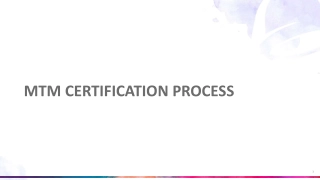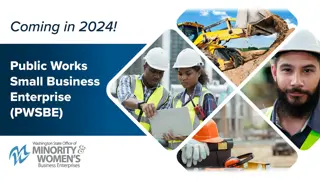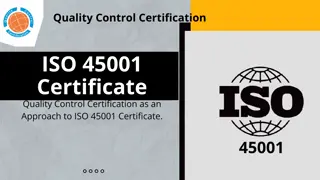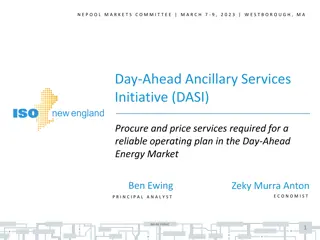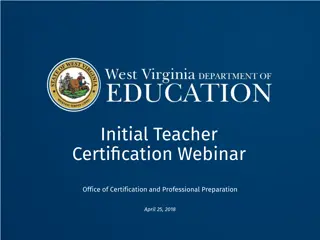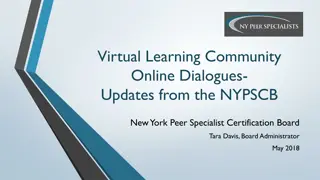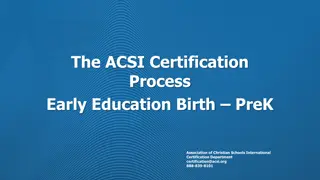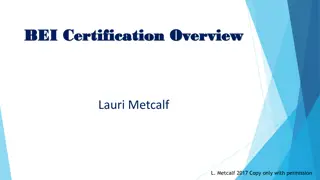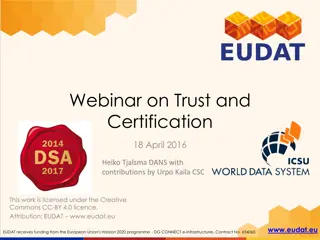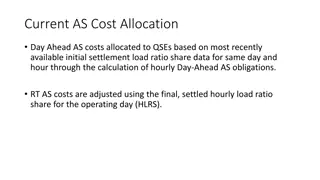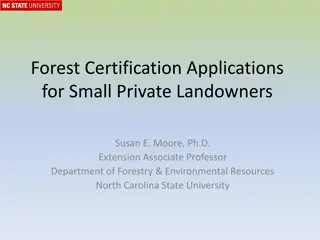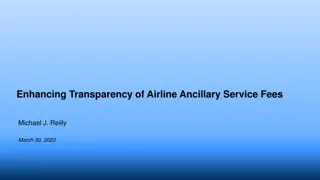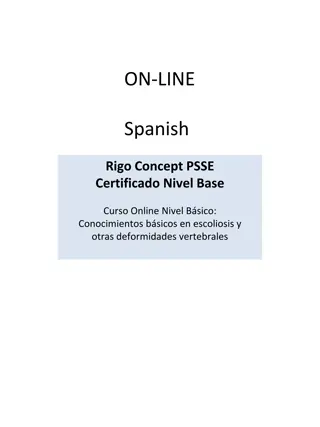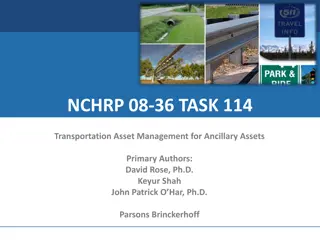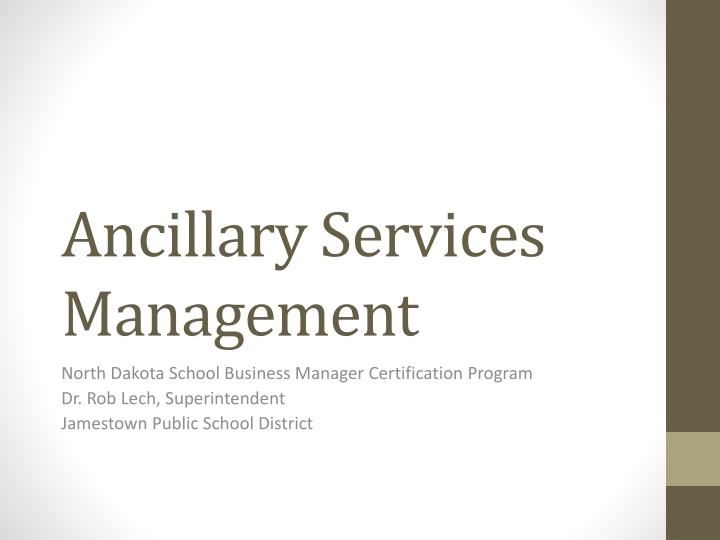
School Business Manager Certification Program in North Dakota
"Gain essential knowledge on school facility planning, budgeting, transportation services, food programs, student activities, and legal agreements in this comprehensive management course. Facilitated discussions and practical assignments enhance learning for school administrators. Explore additional resources to benefit your district effectively."
Uploaded on | 0 Views
Download Presentation

Please find below an Image/Link to download the presentation.
The content on the website is provided AS IS for your information and personal use only. It may not be sold, licensed, or shared on other websites without obtaining consent from the author. If you encounter any issues during the download, it is possible that the publisher has removed the file from their server.
You are allowed to download the files provided on this website for personal or commercial use, subject to the condition that they are used lawfully. All files are the property of their respective owners.
The content on the website is provided AS IS for your information and personal use only. It may not be sold, licensed, or shared on other websites without obtaining consent from the author.
E N D
Presentation Transcript
Ancillary Services Management North Dakota School Business Manager Certification Program Dr. Rob Lech, Superintendent Jamestown Public School District
Course Objectives Through this course, you will demonstrate a basic understanding of: School facility planning and financing/budgeting. Transportation services and budgetary impact. Operating a food service program. Student Activities and their possible budget impact. Joint powers agreements and when a school district may enter into them under law.
Presentation and Resources This session is designed to be as much a resource as it is a presentation. There is a lot of information to cover so some information will be covered in-depth and others will be skimmed. As I want to be sure to meet your needs, please let me know if you would need greater clarification or if you would like to discuss a topic more. There are resources attached to both the PowerPoint and the syllabus that I believe you may find useful. Much of the value of this course, however, will be based on your willingness to share your perspective. Your examples and experiences are the most relevant learning experiences we have and we need to leverage those to learn from each other. I would much rather that we engage in discussions around the content that I share. I will provide my own experiences (i.e. Jamestown s capital projects planning and a partnership for a shared sports complex) to support the learning in the class and to provide an example.
Facilitation of the Course I am a firm believer that you are all the experts here and I would be doing you a disservice by not facilitating discussions for you to learn from each other. Throughout the session, group discussion is crucial to building your collective capacity. As such, your participation is a key piece of this class. I will be using a number of different engagement strategies that, hopefully, keep your interest and encourage you to share your knowledge. Turn and Talks: Talk to the people near you and discuss the question and be ready to share. Pair/Share: Just like a turn and talk, but you need to find a new partner each time. Two Truths and a Lie: You will get a question and three responses. Identify the untrue statement and explain why it is untrue. Guided Questions: These are multiple choice questions. Stand to signify your answer.
Assignments The assignments are designed in a way that you could create something of value that could benefit you and your school district. I fully realize that you all have jobs and families and the assignments are designed to provide options with varied levels of rigor to accommodate you. My preference is you look to the assignments that best fill a gap in your district. These can be a bit time intensive, but are better for you and your district in the long run. There are some options, however, that will provide less of a time commitment up front. These will have a more limited long-term value. I do encourage you, though, to spend the time, if you can. While we will go over the assignment list more in-depth at the end of this session. Beyond the listed assignments, I also want you to think about other potential options, within Ancillary Services, that could support your district right now. I am open to other projects beyond what is listed in the syllabus. These could include documents that you are working on right now for your district. If you have a suggestion for consideration, please visit with me today or via email at Robert.Lech@k12.nd.us. In a perfect world, I want you to walk away from this course with documents that you will find useful as a business manager and that could positively impact your school district.
Q1: TURN AND TALK: WHAT AREA(S) OF ANCILLARY SERVICES ARE YOU MOST CONCERNED WITH AS A BUSINESS MANAGER?
Q2 PAIR/SHARE: HOW HAS YOUR DISTRICT PLANNING USED ESSER FUNDS? ARE YOU STILL USING ESSER?
ND School Districts received millions of dollars in Elementary and Secondary Schools Emergency Relief (ESSER) funding. These generational funds were handled differently in every district and new superintendent s need to be aware of their use and the potential implications. Some districts used funds for one-time expenses to address specific needs of the district (related or not-related to the pandemic). Some districts used ESSER for existing expenditures and built on their interim balance. Some districts added programs and/or personnel to address specific needs of the district (related or not-related to the pandemic). New business managers should be examining how those funds were used and begin to plan if new programs were added or if new staff were hired. Are those sustainable? If not, what needs to be done (non-renewal, communication of program change, new funding source, etc.) ESSER Funding
Q3: PAIR/SHARE: HOW INVOLVED ARE YOU, AS A BUSINESS MANAGER, IN BUILDING PROJECTS? WHAT ARE THE EXPECTATIONS IN YOUR DISTRICT?
School Facility Planning Your role as a business manager may, or may not, include many aspects of school facility planning. In some districts, you will only serve a role on financial matters, while in others, you are asked to be more involved in planning. In any case, it is helpful to understand proper facility planning so you understand the process and can serve whatever role is necessary in your district. Regardless of your particular role, however, it is important to understand the process involved. The needs of your facilities could have a significant impact on your budget. Additionally, any project requiring school construction is going to be a labor-intensive time burden. You want to be sure to conduct the process effectively so you don t need to do it again!
Facility Planning A successful facility plan will typically include seven components: Facility Needs Assessment, Educational Adequacy Study, Demographic Study, Values, Feasibility Study, Determination (Assessment to Decision), and Implementation Plan. Depending on the scope of your potential project, you may want to consider contracting with an architectural firm to assist in the assessment and planning of your project. In this instance, you may want to consider drafting and publishing a Request for Qualifications (RFQ) in which you outline your proposal, scope of project, timeline and requirements and to build a potential pool of applicants.
Facility Planning (cont) Prior to the creation of a school facility plan, it is strongly advised that your district would have first targeted the potential need through a strategic planning committee. This would be completed early in the discussion process and would involve all stakeholders (staff, parents, community members, school board members, administrators). Whether this facility is a school addition, new building, or remodel, your community is rightfully going to want to be involved in the process. Without your community support, you will struggle to get any significant facility updates completed. Community Capacity Building for Facility Planning, when done well, should continually consider three components: Educational Adequacy (How will this help our students?) Facility Needs (How will this update current structures/infrastructures?) Community Support (Will 60% of voters vote for it) Consider 20/60/20 and vested voters. Once a strategic planning committee has targeted new construction/remodel as a goal, you will need to develop a communications plan. Receiving support from those on the committee is only the first step. You need to be transparent and provide multiple opportunities to share the information. The more comfortable the community feels with the plan and the rationale for its need, the more likely it will be approved.
RFI, RFQ and RFP Request for Information (RFI) is used when you need more information from the vendors. It is usually followed by an RFP or RFQ. Request for Qualifications (RFQ) is used when you know what you want, but need information on how vendors would meet your requirements and how much it would cost. Request for Proposals (RFP) is when you know you have a problem, but don t know how you want to solve it. This is the most formal of the three processes and has strict procurement regulations.
Q4: TURN AND TALK: HOW DOES YOUR DISTRICT DETERMINE AND PRIORITIZE FACILITY NEEDS?
Preventative vs Deferred Maintenance Preventative Maintenance is maintenance that is conducted through regular/systematic inspection that precedes a major inefficiency or system failure. Deferred Maintenance is maintenance that is necessary to maintain an effective and efficient facility, but has not yet been completed due to organizational or financial constraints. There is an expected life-cycle to buildings and your district needs to have a plan for maintenance, but also for system replacement. Methods to track and prioritize preventative and deferred maintenance varies on school. In some districts, a facility director tracks and reports these needs, while in others it becomes the responsibility of an administrator to prioritize these needs.
Facility Maintenance Planning I think it is important for districts to maintain a formalized plan for facility maintenance. I believe that many districts do a poor job in creating and adhering to a plan to address facility needs. Start with a simple facility breakdown and keep building worksheets to help your district manage facilities. In many districts, it is an unscientific process in which building administrators and potentially building/grounds personnel work to prioritize needs that will be conducted in the short-term. It is usually a very reactive process. The benefit would be that you are able to address timely issues by gathering building-level perspective. A capital projects plan outlines a few important criteria. It outlines present conditions, project needs, expected timeline, annual allocated amount along various schedules. From a facility and a budgeting standpoint, a maintenance plan will provide a proactive process to addressing a district s needs in the short and long-term.
Capital Projects Planning It is important to not be simply reactive to facility needs. School districts should have a long-term plan, across various schedules, for facility needs. In my experiences, larger schools are able to do this more easily because they have the professional capital and resource to devote to the creation and maintenance of a capital projects plan. It is equally important, however, for smaller schools to make this commitment. The benefits of a capital projects plan include: The breakdown allows staff to coordinate better when projects are coming. Agnostic of changing leadership Helps to better communicate facility needs to stakeholders Makes for better long-term decision-making for facility needs.
Capital Projects Plan Exemplar While there are many different ways that a Capital Projects Plan can be designed, review the Jamestown Public Schools Capital Projects Plan, and consider the following questions: How might this plan better articulate the facility needs of the district to stakeholders? How could this benefit a school district in facility planning? Is this an example that could be used in your school district? How would it look different to meet your own individual needs?
Facility Needs Assessment Regardless if you have used a formal or informal process of facility assessment, there are seven things that should be explored in a facility assessment: Physical conditions of current buildings Conditions of mechanical/electrical systems Deferred Maintenance Compliance Issues (ADA/OCR) Comfort Issues (HVAC) Possible Savings (Efficiencies) Other deficiencies
Q5 PAIR/SHARE: WHAT IS EDUCATIONAL ADEQUACY AS IT RELATES TO FACILITY PLANNING?
Educational Adequacy Educational Adequacy can be a tough area to communicate because some of it is very tangible (i.e. safety, capacity, etc.), but other areas are much more difficult to articulate to external publics (teaming, flexible learning spaces, etc.) due to professional jargon and lack of familiarity with current educational trends. There are five areas to study when considering the educational adequacy of your facilities. Conducting a walkthrough and overall site plan with architects will assist in these areas. Also, you will want to consult and have cohesion and support through your strategic plan. Safety and security Building capacity Space capacity (classroom size, cafeteria, support services, labs, gymnasium space, etc.) Current educational trends (i.e. teaming/collaboration space) Technology infrastructure
Guided Question #1 Has your school district conducted an enrollment study? A. Yes B. No
Demographics Study The purpose of the enrollment/demographics study is to explore enrollment trends in your district to ensure you plan for adequate student numbers. In some districts, and with some projects, this may prove unnecessary, but in others it is a crucial step in the process. This can be as simple as an enrollment study and basic projections using cohort groups or as complicated as hiring a demographer to study your community (economic development, housing, school boundaries, etc.). If you are going to contract for a demographer, it is important that you plan for the right type of demography study. There are formal micro-level demography studies that focus on school enrollments. The demography studies that are conducted by cities, for example, could provide you with some information, but they generally focus on number of homes for infrastructure planning. Unless it includes a yield rate for students per home, it will have limited value to your school district.
Values The values of the school district must be congruent with the values of the community. If they are not, you will struggle with finding support for even the smallest projects. There is a critical balance between stakeholder input and decision-making. If your feedback loops are not representative of your community, you will get the wrong plan. The wrong plan won t be supported and it also will hurt future projects and asks. In many of our communities, we get one chance to take on a big project. We need to make sure it is done right and is congruent. It is critical in developing stakeholder support to conduct a needs/wants assessment. This likely would include staff, community and possibly students.
New Realities with Building Projects In the current economic and political climate, it is harder and harder to pass referendums. Your planning process must consider all manners of outcomes and solutions. Pair/Share Question: Has your district ever considered business/community partnerships to build facilities? What has that looked like? What did you learn from it? Resource: Recently NDSBA had an outstanding presentation from Scott Wegner at Arntson Stewart Wegner on school construction and he compiled a wonderful resource on school construction.
Jamestown Public Schools/UJ Shared Facilities Hansen Stadium Erstad Field
Feasibility Study Once your district s leadership committee has determined your needs, you will need to determine what you can afford and how it will be paid for. You will also need to consider the timing in bringing the issue before the public if you are pursuing a bond referendum. Areas that can positively impact a move towards a referendum: Retiring Debt Various Studies (enrollment, efficiency, facility assessment, etc) School Construction Loan/Low Interest Rates Special Funding Opportunities (Fundraising, ESSER, Other Opportunities) *Fundraising is an area that schools are going to need to consider with more frequency. Who are the people/businesses in your community that may provide opportunities for giving? Rule of Thumb: Naming opportunities are often the most utilized fundraising for capital projects. Consider 35%-50% of the cost of construction for naming rights. For example, a new health and wellness center is built costing $1 million. You d be requesting $350,000 - $500,000 to call it the Patty Verdouw Health and Wellness Center.
Two Truths and a Lie Consider the following 3 statements and determine which are the two truths and which is the lie Schools are not allowed to stuff backpacks with referendum information. Schools are not allowed to put Vote Yes posts on social media. School officials can attend Vote Yes committee meetings to provide resource information.
Determination (Assessment to Decision) Seek input through committees (design and facility) It continues to be important to gather community support through transparency and communication. Again, however, you will want to ensure that proper hierarchy is in place so all understand if they are making a decision or a recommendation. I would recommend creating some type of Citizen s Advisory Committee that is tasked with analyzing the various resources, prioritize needs, and ultimately bringing a recommendation to the board. This would need to be representative of the community and staff, inclusive of board members and central office staff, and involve experts like your Construction Manager and/or architect. Determine what is needed through prioritization of needs/wants. There are tools to help to prioritize among different variables. Forced Choice is a tool I use frequently, in many different areas, to come to consensus. Review cost estimates. Review benefits (costs savings, health issues, efficiencies, educational impact, etc.) This may include visits to recently built facilities that are similar in scope to your proposed plans.
Forced Choice Review the Forced Choice activity. We will walk through the 6x6 grid together. I have found the forced choice to be a helpful tool in prioritization. A few valuable aspects of the forced choice are: It reduces the focus on the loudest voice or most influential member of the team. Limits the impact of pet projects because each variable needs to be prioritized and scaled. When discussion is held around each variable and choice, it leads to a good dialogue and better understanding of perspective. Ultimately helps to make the best decision for all perspectives.
Implementation Any bond issue, or proposal to use school funds for building or enhancing facilities is going to require sufficient communication. The focus needs to be on how the community needs to hear the information and not on how the school provides it. If moving forward with a bond referendum, I would suggest a Yes committee is established by key stakeholders (not the school). A Citizen s Advisory Committee could serve this role if you implemented that model. This group, not led by the district, will get the word out and share subjective information that the district is not able to provide. Additionally, the school administration, and potentially business managers, should be willing/able to present whenever and wherever possible. It is your responsibility to communicate this project to the public with strictly objective.
Determining Funding Sources The business manager is likely going to play a critical role in determining the best options for funding sources. Sources include bonds, state loans, federal funding, and potentially building fund depending on the scope of the program and funding capacity. It is advisable to work with a financial manager, such as Public Funds Management (PFM), to help determine your funding capability and all potential options. Sample Referendum Resolution Language
State Approval Process for Construction If a project is proposed to reach certain financial thresholds, you may be required to receive approval from the Department of Public Instruction prior to beginning the construction process (Construction Approval Application or Facility Plan). You need to be familiar with these thresholds to ensure that you are in compliance with these regulations. If the project is expected to be under $150,000 you will not need to submit paperwork to DPI, but you should proceed with caution. If the project ends up over $150,000, you will be out of compliance with these requirements. I would suggest that unless you are sure it will be less than $150,000, you submit the appropriate forms just to be safe. A Facility Plan is triggered by a cost of $350,000 or more and/or new square footage.
Construction Approval Form You will need to complete the construction approval form if the project is under $350,000 and does not add new square footage to the facilities. This form does require school board approval so plan appropriately.
Facility Plan If the proposed construction will cost more than $350,000 and/or creates additional square footage, you are required to complete a Facility Plan (Exemplar) If you have completed a Facility Plan within the last three years, you only need to complete the necessary pages that address the change and the Construction Approval Form. If you have not completed a Facility Plan within the last three years, you will need to complete the entire form and the Construction Approval Form. The approval process may take up to 60 days, so plan appropriately.
Construction Bidding Process When doing a major project (i.e. any project in which you are required to bid) you likely will be working with an architect on the facility plan. The architect will assist your district in the drafting and submission of a construction bid. You would also likely be working with a financial manager to assist with the bond. An example of a bid for construction is from a project at Gussner Elementary in Jamestown. In this case, it was drafted by Zerr Berg, who were the architects for the project.
School Construction Loan Programs There are two options currently for school construction loans through the state: Coal Development Trust Fund and School Construction Assistance Revolving Loan Fund (See Part 8 in School Construction Finance Document) Access to these programs require an application through DPI along the school construction and facility plan forms.
Q6 TURN AND TALK: WHAT IS THE PRESENT BUILDING FUND LEVY IN YOUR DISTRICT?
Guided Question #3 What is the most common number of building fund mills levied? A. 5 B. 8 C. 10 D. 20
Building Levy The building fund, along with special assessments, makes up Fund Group 3. A school district reorganization plan may have allowed your district to levy up to 10 mills, but the majority of districts are governed through NDCC 57-15-16 which gives districts the ability to levy up to 20 mills in the building fund if given voter authority through 60% voter approval. While there are a handful of school districts that do not levy for a building fund, the most common levy is 10 (followed by 5).
Two Truths and a Lie Consider the following 3 statements and determine which are the two truths and which is the lie Schools can utilize the building fund to pay for a lease agreement for a facility. Schools can expense architectural fees through the building fund. Schools can utilize the building fund to pay for the facility director s salary.
Q7 PAIR/SHARE: WHAT DO YOU EXPENSE THROUGH THE BUILDING FUND?
Use of Building Levy NDCC 57-15-17 - Disposition of building fund tax. The funds may only be used for the following purposes: (1) The construction of school district buildings and facilities; (2) The renovation, repair, or expansion of school district buildings and facilities. (3) The improvement of school district buildings, facilities, and real property; (4) The leasing of buildings and facilities; (5) The payment of rentals upon contracts with the state board of public school education; (6) The payment of rentals upon contracts with municipalities for career and technical education facilities financed pursuant to chapter 40-57; and (7) The payment of principal, premiums, and interest on bonds issued in accordance with subsection 7 of section 21-03-07. In very limited circumstances, there are options to transfer building fund moneys into the general fund. Be sure to check NDCC 57-15-17 subsections 2-4 carefully, as the options to do so are listed explicitly.
Requirements for Transporting Students NDCC 15.1-30-01 outlines a school district s option for the ability to transport students. Your district should have a policy specifically related student transportation. Note: You may have reorganization plan or local policy that requires transportation. You may have a legal obligation to transport special education students, depending on their needs and Individualized Education Plan (IEP).
Transportation Funding A portion of transportation funding is provided through the state aid formula. Miles driven are paid at varying rates for large and small buses, rides are also paid at varying rates, and family travel (to school and to the bus) is also provided. The rates are as follows: Small Bus Miles - $.52 Large Bus Miles - $1.10 Small In-City Miles - $.52 Large In-City Mils - $1.10 Rural Rides - $.30 In-City Rides - $.30 Family Payment to School (Per Mile) - $.25 Family Payment to Bus (Per Mile) - $.25 Transportation, in most districts, has been funded only around 30% - 40% by state funds. The remainder needs to be picked up by the school district. Separate levy authority no longer exists for transportation, as it was rolled into the miscellaneous fund.
Guided Question #4 Do you own or contract for transportation? A. Own B. Contract C. Both
Own vs Contract Depending on your school district, you may own and operate a fleet of buses or you may contract with a bus service. A typical agreement for contracted bus service would include: Length of the Contract, Insurance/Liability/Indemnity, Routes, Equipment/Vehicles, Driver Responsibility/Requirements, and Compensation. Simply, you are going to expend more dollars to contract, but you will have less responsibilities (drivers, maintenance, fleet upkeep, etc.).
Renewal of Transportation Contract If you are a district that contracts for bus service, you are allowed to renew your contract, however NDCC is fairly specific about the process that should be followed.

